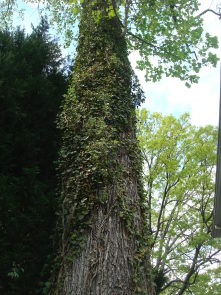If you have English ivy in your yard, be a good neighbor and manage it or, better yet, remove it.

In last week’s blog, I wrote that a simple way to help the local environment is to and to help remove them from your yards and from public areas.
One of the most serious local NNI plant threats is a vine that is commonly seen in people’s yards and in our natural areas. In fact many people plant this vine and encourage its growth in their yards.
This vine is English ivy. English ivy may look harmless, but if left unchecked it can become very destructive. In Sligo Creek Park for example, “Weed Warriors” are kept busy fighting the English ivy that has escaped homeowners’ yards. On the ground English ivy spreads rapidly, displacing native wildflowers and other native plants by smothering and choking off the native plants. Because it is exotic, it provides little to no biological value for our native creatures. When English ivy predominates, other plants tend to disappear. Many birds and mammals are forced to move on to find food and appropriate cover.
Because English ivy has shallow roots, it provides poor soil erosion control. Soil erosion causes excessive sediment in our streams. Sediment is one of the region’s biggest water quality problems. English ivy, if left unchecked, will also climb trees where it may kill them. Over time English ivy can add substantial weight to the tree. During wind or snow/ice storms, trees that are covered with ivy frequently snap or topple over.
If you have English ivy in your yard, be a good neighbor and manage it or, better yet, remove it. It is especially important not to let English ivy climb trees. Not only could it kill the tree over time, but when it climbs trees, English ivy will flower and go to seed. Once it goes to seed, birds eat it and disperse it in your neighbors’ yards and in our parks. Areas covered by English ivy create habitat for rats including great vegetated tunnel systems and hiding spaces.
Friends of Sligo Creek’s website provides useful information on how to remove English ivy: www.fosc.org/EI-Removing.htm
Our natural areas and our trees provide many important environmental services. Come to our April 24 (Tuesday) GreenWheaton meeting to learn about Conservation Montgomery’s efforts to save our trees and natural areas and what you can do to help right here in Wheaton. The program meeting starts at 7:30 at the , 2424 Reedie Dr., Wheaton MD 20902.


